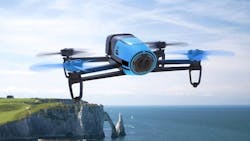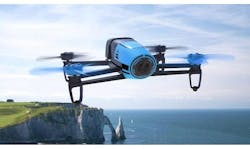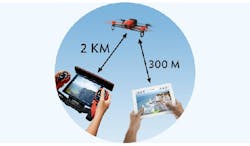Q&A: Parrot’s Loury Reveals Details on the Bebop Drone
This file type includes high resolution graphics and schematics when applicable.
Parrot’s Bebop Drone (Fig. 1) features a 14-Mpixel HD camera with a fish-eye lens, enabling it to take videos and pictures with a 180° view. What is very impressive about the system is that the video streamed via Wi-Fi is digitally stabilized by the Bebop, which is great for first person control of the drone as well as providing excellent recorded video.
I recently spoke with Vanessa Loury, PR Director for Parrot, about the Bebop Drone.
Wong: What are the main features of the Bebop Drone?
Loury: The Parrot Bebop is a very light leisure drone with a full high-definition, 14-Mpixel, fish-eye lens camera that has the ability to take videos and pictures in a 180° view. Its three-axis framework and numerous sensors give the Parrot Bebop Drone impressive stability and easy-to-use piloting via Wi-Fi with a smartphone or tablet. The Parrot Bebop Drone also is compatible with a Wi-Fi extender, the Parrot Skycontroller, which can be used to pilot the Bebop and provides an extended flight range.
Wong: What are the major changes between the AR.Drone and the Bebop Drone?
Loury: The Parrot Bebop and the AR.Drone 2.0 (see “Smartphone Controls Low-Cost Quadrotor”) are different products altogether. Both drones are compact and light (less than 500 g).
The main difference between the drones is in the camera. Where the Parrot AR.Drone 2.0 is equipped with a camera with 1280 x 720 resolution, the Bebop is equipped with a 14-Mpixel “fisheye-lens” camera that records video in full HD (1080p x 1920p). Furthermore, the pilot of the Bebop Drone can control the angle of the camera with their thumb, through the piloting app Free Flight 3.0, to adjust the angle of the view on a 180° angle. Then, it can film or take pictures vertically.
Wong: What is the return home feature?
Loury: If needed, pressing the “Return Home” button makes the Parrot Bebop Drone automatically fly back to its take-off position, guided by GPS coordinates.
Wong: What is FreeFlight 3?
Loury: The Parrot Bebop Drone comes with a free piloting application, FreeFlight 3.0, for iOS, Android, and Windows Phone smartphones and tablets. It enables access to all of the functionalities of the Bebop, including take off, tilt of the camera, rotation, etc. The ergonomics of the application have been developed to offer ease-of-use and allows the pilot to focus on the pleasure of flying.
Wong: How does the Bebop Drone Skycontroller work with a tablet?
Loury: The Bebop Drone Skycontroller (Fig. 2), an RC-like remote control equipped with a Wi-Fi amplifier powered by an amplified Wi-Fi radio and four antennas, provides an even more powerful Wi-Fi connection. The piloting smartphone or tablet is fixed on the control dock and streams what the Bebop Drone is seeing on its screen.
Wong: What can you do with the FreeFlight 3 SDK?
Loury: The Parrot Drone’s SDK contains source code that allows developers to connect with all compatible drones, including our Minidrones Jumping Sumo, Minidrones Rolling spider, Bebop Drone and Skycontroller. We provide the tools to compile sources as well as samples files showing how to use the SDK.
Developers are able to create programmable flight plans that compatible with MAVLink, a popular open-source drone control protocol. Applications can retrieve recorded pictures and videos as well as live streaming video. The system can handle 3D mapping. It can be used to create remote control with new devices as well as new piloting apps.
Wong: What affect will the new FAA rules (see “FAA Defines Drone Rules”) have on Parrot and its customers?
Loury: Parrot drones have the ability to customize the firmware in accordance with regulations, such as capping the flight ceiling of our products at 400 ft., and we currently do this for the standards set in the U.S. Parrot also provides safety-recommendation information in each product packaging, and advises Parrot drone owners to review and adhere to flight guidelines for their country.
Wong: Where do you see quadcopter technology going in the next few years?
Loury: Parrot continues to grow and innovate in the drone technology space and today, we have the most extensive range of super-light civil drones in the consumer market with our Minidrones, AR.Drone, and Bebop lines, and professional market with the eBee and eXom drones by senseFly.
This file type includes high resolution graphics and schematics when applicable.
We strongly believe in the potential of drones. As one of the leaders in drone technology, we are already involved in many fields including surveying, agriculture, GIS, industrial inspection, and mining. In agriculture, for example, drones help to identify the need for fertilizer in a field’s plot. This allows for a better understanding of what is happening in a field, which allows for more economic, efficient, and green agricultural development.
About the Author
Vanessa Loury
Public Relations Director
Vanessa Loury is the Public Relations Director at Parrot. Prior to Parrot, she was the Senior Public Relations Manager at Symantec and Director of the Technology Practices for Weber Shandwick France.
William G. Wong
Senior Content Director - Electronic Design and Microwaves & RF
I am Editor of Electronic Design focusing on embedded, software, and systems. As Senior Content Director, I also manage Microwaves & RF and I work with a great team of editors to provide engineers, programmers, developers and technical managers with interesting and useful articles and videos on a regular basis. Check out our free newsletters to see the latest content.
You can send press releases for new products for possible coverage on the website. I am also interested in receiving contributed articles for publishing on our website. Use our template and send to me along with a signed release form.
Check out my blog, AltEmbedded on Electronic Design, as well as his latest articles on this site that are listed below.
You can visit my social media via these links:
- AltEmbedded on Electronic Design
- Bill Wong on Facebook
- @AltEmbedded on Twitter
- Bill Wong on LinkedIn
I earned a Bachelor of Electrical Engineering at the Georgia Institute of Technology and a Masters in Computer Science from Rutgers University. I still do a bit of programming using everything from C and C++ to Rust and Ada/SPARK. I do a bit of PHP programming for Drupal websites. I have posted a few Drupal modules.
I still get a hand on software and electronic hardware. Some of this can be found on our Kit Close-Up video series. You can also see me on many of our TechXchange Talk videos. I am interested in a range of projects from robotics to artificial intelligence.




